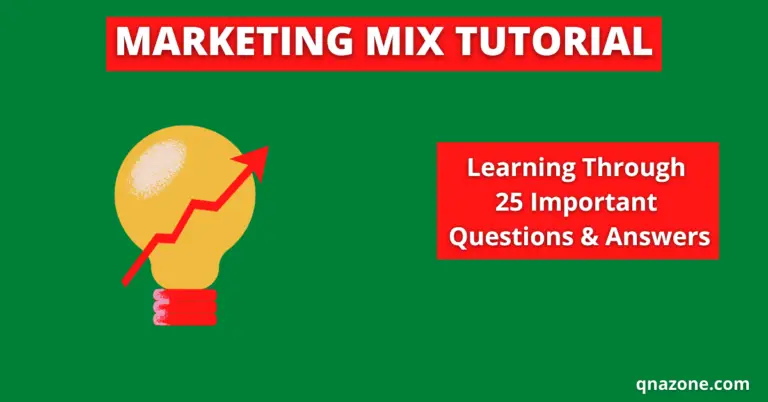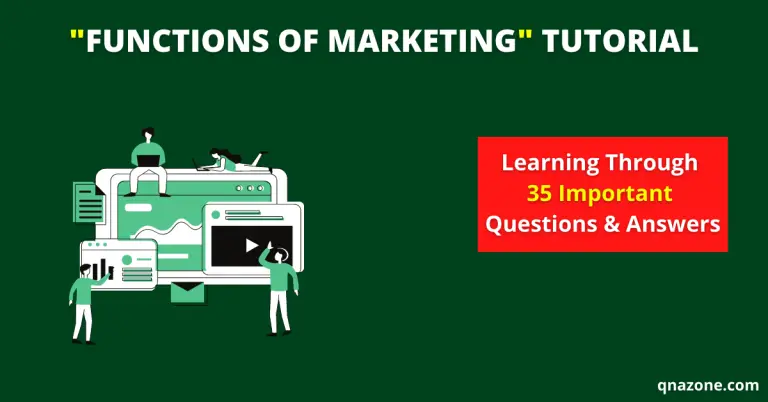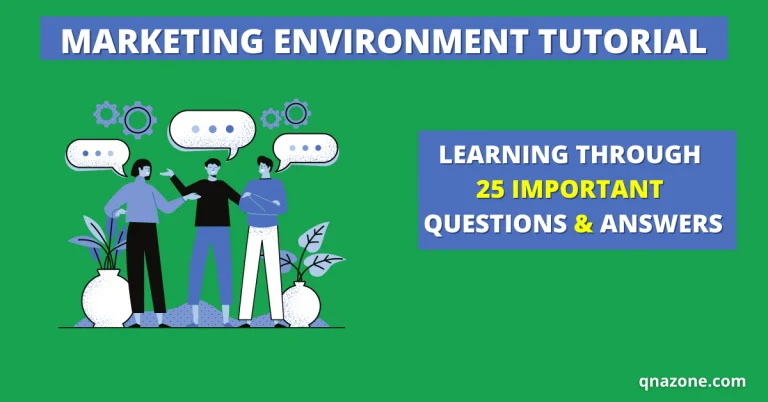30 Important Introduction to Marketing Questions and Answers [Notes with PDF]
The first chapter of our marketing learning course is “Introduction to Marketing”. In this article, we’ll learn the 30 most important introduction to marketing questions and their answers.
If you read every question and its answers carefully, you will be able to prepare for the marketing course in a very good way.
By reading this post, you may quickly prepare for any competitive tests such as school and college exams, vivas, job interviews, and so on.
Introduction to Marketing Questions and Answers:
The 30 important “introduction to marketing questions and answers” are as follows:
Question 01: What is marketing?
Answer: Marketing is the process. It discovers the consumers’ human and societal needs during this phase and makes efforts to meet them.
Marketing is a comprehensive system of business activities that includes planning, pricing, promoting, and distributing want-satisfying items to target markets to achieve organizational goals.
It is the goal of marketing to provide value to customers. Develop profitable buyer relationships. To obtain value from buyers and to execute business activities to meet their wants.
Question 02: What is the brief history of marketing?
Answer: The brief history of marketing is as follows:
The era of self-sufficiency: In the early days of human civilization, every human being was self-sufficient and produced their necessities.
The era of exchange: The people of this age exchange their surplus products for mutual needs.
The era of production: (1600-1930 AD) in this age, many people try to profit by exchanging surplus goods by producing more goods.
The era of sale: ( 1930-1950 AD) In this era, the volume of production increased as production efficiency and the number of producers increased. It creates an opportunity for consumers to purchase the desired product.
The era of marketing: (After 1950 AD), consumers become aware of their needs and wants during this time. Moreover, as competition increases, the production of goods or services begins with an emphasis on consumer satisfaction.
The era of social marketing: (After 1970 AD) in this era, various elements of society began to dominate the world, resulting in a change in marketing philosophy. During this time marketing companies began to focus on making a profit as well as the welfare of the people living in the society
The era of relationship marketing: (After 1990 AD), marketers become more proactive in establishing good relationships with buyers and other parties. The key to marketing is to build good relationships with customers and turn them into regular customers.
The era of social networking/ Digital marketing: (After 2000 AD) the current era of marketing is called social media and mobile marketing. It is the age of promoting products and services through various social media using internet technology.
Question 03: What are the features of marketing?
Answer: The 12 important features of marketing are as follows:
- Value-adding activity
- Social Process
- Managerial process
- Economic process
- Exchange process.
- Consumer-oriented process
- Dynamic process
- Searching process
- Integrated process
- Existence of a middleman
- Marketing is applicable.
- Marketing is profit-oriented.
Question 04: What are the five marketing concepts?
Answer: The five (5) marketing concepts are as follows:
- The production concept
- The product concept
- The selling concept
- The marketing concept
- The social marketing concept
Question 05: What is the production concept?
Answer: The production concept refers to the idea that buyers should focus on the product’s adequate supply and purchasing power.
The production concept is the oldest marketing concept. This concept originated during the Industrial Revolution and was widely adopted between 1869 and 1920.
This concept is still effective in reducing labor costs, increasing production efficiency, and providing a comprehensive distribution system in a competitive and price-sensitive market.
This concept, however, undervalues the implementation of activities and fails to generate consumer satisfaction and customer relationships.
Question 06: What is the sales concept?
Answer: The sales concept refers to the idea of increasing profits by increasing sales. This school of thought holds that buyers must be motivated and persuaded to buy.
The sales concept assumes that unless the organization tries to sell and expand on a large scale, consumers will not buy enough of the company’s products.
As a result, marketing activities must be prioritized to increase product sales. The period from 1930 to 1950 is regarded as the sales concept period.
This concept prioritizes immediate sales over long-term profitable buyer relationships.
Moreover, in this concept, the sale of the company is aimed at selling the products produced. Does it not matter what the market demand is?
Question 07: What is the social marketing concept?
Answer: When marketing activities are carried out to achieve consumer satisfaction while also serving the welfare and interests of society and people, this is referred to as the social marketing concept.
A socially oriented marketing concept assumes that when making marketing decisions, a company should consider the needs of the consumer, the needs of the company, the long-term interests of the consumers, and the long-term interests of society.
There are three major factors to consider when developing marketing policy, according to the social marketing concept: 1. preserving the company’s profits, 2. consumer needs, and 3. societal interests.
Question 08: What are the three major functions of marketing?
Answer: The functions of marketing are as follows:
- Exchange Functions:
- Buying
- Selling
2. Distribution Functions:
- Transportation
- Warehousing
- Packaging
3. Facilitating Functions:
- Financing
- Risk-taking
- Standardizing and grading
- The collection of market information
- After-sales service
Question 09: What are the benefits, or advantages, of marketing?
Answer: The following are the 12 important benefits or advantages of marketing:
- Satisfaction with a social need
- Production will increase.
- Distribution of commodities in an efficient manner
- Price level stability in lending.
- Diversification of consumption
- Taking steps to reduce business risks
- Employment
- The development of industrial arts
- Relationship development
- Appropriate use of natural resources
- Improvements in living standards
- Economic and social progress
Question 10: Why is marketing a process-oriented activity?
Marketing is how businesses provide value for customers and establish strong client relationships to receive value in return.
Marketing is a method. It discovers the consumers’ human and societal needs during this phase and makes efforts to meet them.
Marketing entails both social and management responsibilities. Marketing, on the other hand, completes these activities inside a defined framework. As a result, marketing is referred to as a process-based activity.
Question 11: What role does marketing have in everyone’s life?
Answer: Marketing is how businesses provide value for customers and establish strong client relationships to receive value in return. Marketing is responsible for all of the goods and services we have today.
The locations of production and consumption are frequently not the same. Generally, we buy goods only when they are brought to our attention and we want them.
And marketing has a role in product launch and buyer interest, whether directly or indirectly. As a result, marketing plays a significant role in everyone’s lives.
Question 12: Why is marketing a value-added activity?
Answer: Marketing is a service that adds value to the customer’s experience. Value addition activity is defined as the process of adding new value to a product’s current value by generating additional usefulness.
For example, by moving the farmer’s products to the city and producing place utility, the new value is added to the product’s current value.
As a result, city buyers are willing to spend extra because they can readily obtain the product. By building place utility, values have been added.
The marketer performs product design formulation, production, brand determination, market generation, packaging, supply, and support services as a value-added marketing activity.
As a result, value is added by marketing activities that create new utilities. Marketing, in other words, is a value-added activity.
Question 13: Why is marketing called an economic process?
Answer: Marketing is a process by which companies create value for buyers and build strong customer relationships to gain value from them in return.
Marketing is called a managerial, social, and economic process because every act of marketing is involved in the economic process.
A variety of utilities are created by marketing work, creating measurable demand through money and whose exchange value exists.
Marketing is considered an economical process because buyers are willing to pay the price to meet such demand.
Question 14: Why is marketing called a dynamic process?
Answer: Marketing is a dynamic process. In the present age, the standard of living of consumers, tastes, preferences, purchasing power, purchasing behavior, etc., are changing with time.
Marketing policies, activities, methods, etc., are constantly changing to keep pace with the changing needs of the consumers. So marketing is called a dynamic process.
Question 15: Why is marketing called an integrated process?
Answer: The main goal of marketing is consumer satisfaction. The marketer alone can’t perform all the tasks to satisfy the consumer.
The responsibilities of each department have to be specified by dividing the marketing work into different parts. And only through the concerted efforts of each of these departments is it possible to achieve the purpose of marketing.
For this reason, the marketer arranges the division of tasks and the coordination of those tasks. Therefore, marketing is considered an integrated process.
Question 16: What is a customer?
Answer: A customer is a person who purchases a product or service. A customer buys a product for one of three reasons.
- to profit from the sale.
- To be used in subsequent production with the intention of profit.
- To be used or enjoyed by oneself or one’s family.
A customer is someone who, for whatever reason, buys a product or service from someone else for money or interest.
Question 17: Why are all the techniques of marketing formed based on customers?
Answer: In the current competitive market system, all marketing strategies are formulated with the customer in mind.
There are wide differences among consumers regarding needs, demands, preferences, tastes, purchasing power, purchasing habits, financial capacity, etc.
There is also a difference in the customers’ satisfaction due to the difference in all these things.
For this reason, to provide customer satisfaction, the marketer has to formulate a marketing strategy considering the buyers’ issues.
Therefore, we can say that all marketing strategies are formulated with the buyer in mind.
Question 18: What is a consumer?
Answer: A person who consumes or uses a product is referred to as a consumer. In other words, a consumer buys or uses things or services for their pleasure or convenience.
As a result of such consumption or use, the substance’s usefulness is depleted, and the substance becomes obsolete at some point.
A student will be regarded as a consumer of the paper if they complete writing on paper acquired from the market.
When he tosses the paper away or sells it as old paper, it must be of new use to someone else.
Question 19: What is the significance of the phrase “the consumer is king”?
Answer: Those who buy goods for consumption are called consumers. Consumers consume the product and exhaust its usefulness.
And all marketing activities revolve around such consumers. Marketing activities have to be done based on consumer needs, demands, preferences, tastes, purchasing power, purchasing habits, etc.
The purpose and goal of marketing are to determine and implement for the provision of consumer satisfaction.
Therefore, the concept of marketing, marketing mix, market segmentation, type of marketing method, etc., have to be determined with emphasis on customer satisfaction.
As a result, the consumer is considered the “king” of marketing goods or services.
Question 20: What is the difference between a customer and a consumer?
Answer: Although the buyer and the consumer appear to be similar in general, there are some distinctions in purchasing purpose, use, type of purchase, marketing, and so on.
The 3 important differences between customer and consumer are as follows:
- A buyer is a person or organization who purchases a thing to resell, use, or consume. On the other hand, a consumer is a person or organization who purchases a product or service to consume or utilize.
- A consumer buyer purchases for personal use, a business buyer purchases for profit, and a producer purchases for production. On the other hand, consumer purchases are made only to use the goods or services.
- The buyer must pay a reasonable price for the product. On the other hand, you don’t have to be a buyer if you want to be a consumer. It is also possible to consume a product by donating or receiving one that others have purchased.
Question 21: What exactly does “customer value” imply?
Answer: Customer value combines product quality, service, and pricing that reflects the customer’s attitude toward the product or service.
When the price of a product rises while the quality and service of the product rise, the customer’s value rises as well. On the other hand, if the price or cost rises while the product’s quality remains unchanged, the customer’s value declines.
Customers do not always perform a thorough or deliberate analysis of the product’s value and cost. choose things depending on their perceived worth.
If the price is higher than the level of satisfaction, customers can opt for alternate products or products from competitors.
Question 22: How does marketing create customer value?
Answer: Customer value is the customer’s attitude towards the product or service, which combines product quality, service, and price.
Creating customer value increases loyalty to the organization among buyers. It makes it possible to retain them in the long run.
For this reason, one of the purposes of modern marketing is to create customer value. One of the ways to create customer value is to build customer loyalty, build and maintain good relationships with customers, and use some of the money from customers to improve the quality of goods and services.
Moreover, it is possible to create value by providing consumer goods and providing more benefits than the money spent.
Question 23: Why are all customers not consumers?
Answer: All customers are not consumers. Although there is no apparent difference between the Customers and the consumers, the two issues are no longer the same.
Customers and consumers need to be defined to explain the matter.
A customer refers to an individual or organization that buys a product for further sale, use, or consumption. On the other hand, a consumer is a person or organization that buys a product or service to consume or use.
If we analyze these two definitions, we can notice that the consumer is a part of the customer because the buyer’s purchase is to resell or reuse or consume. The purpose of consumer purchase, on the other hand, is only to use or consume.
That means consumers never resell it. So it turns out that all consumers are customers, but not all customers are consumers. In a word, not all consumers are consumers.
Question 24: What is a market?
Answer: A market is a group of present and future customers for a product or service.
If present and potential purchasers have the money, the desire to spend money, and the right to buy to fulfill a lack of products and services, it is considered a market.
The market is a collection of people who have a demand for and a shortage of a specific product and the ability, desire, and right to purchase it.
Question 25: What is the difference between market and marketing?
Answer: Although the semantic and practical meanings of the phrases market and marketing are similar, there are significant differences between them.
The top 3 differences between market and marketing are as follows:
- The market is the sum of a product’s existing and future buyers. On the other hand, marketing is the process of creating and exchanging product value for individual and organizational reasons by adopting and implementing a price, expansion, and distribution strategy.
- The market’s primary goal is to facilitate communication between buyers and sellers. On the other hand, the goal of marketing is to help customers and sellers achieve their objectives.
- The market is about products and people. The functions of individuals or organizations participating in the exchange of products or services, on the other hand, are referred to as marketing.
Question 26: What is a sale?
Answer: The sale is when the ownership of the product is transferred from the seller to the buyer. But sales work is not only involved with the transfer of ownership of the product.
From a marketing point of view, selling is transferring ownership of a product through determining consumer needs, creating demand, finding buyers, advising on products, and negotiating.
Question 27: What is the difference between sales and marketing?
Answer: Many people think of sales and marketing as synonymous and use one instead of the other. But there is a big difference between the two words.
The following are the three most important differences between sales and marketing:
- The purpose of the sale is to transfer ownership of the product or service. On the other hand, the purpose of marketing is to find out the buyer or consumer’s needs and achieve customer satisfaction by providing products or services accordingly.
- The scope of sales is extremely limited. On the other hand, the scope of marketing is wide and wide.
- Sales begin after the product’s production. On the other hand, marketing begins before the product is even produced.
Question 28: What is marketing’s role in a developing country’s economy?
Answer: The following is the role of marketing in a developing country’s economy:
- Development of agriculture
- The growth of the industry
- Co-ordination of agriculture and industry
- Co-ordination of output and consumption
- Employment
- Improved living standards
- Increased exports
- Development of communication system
Question 29: What role does marketing play in the rise of living standards?
Answer: The following is the role of marketing in the rise of living standards:
- Creating place utilities
- Creating a time utility
- Assisting large-scale production
- Employment
- Changes in purchase pattern
- Co-ordination between demand and supply
- Keeping the economy stable
- Appropriate usage of resources
- Buying a product at a lower price
- Changes in mentality
- A wide range of choices and consumption
- Expansion of the international market
Question 30: What role does marketing play in the creation of job opportunities?
Answer: Marketing is how businesses create value for their customers and establish strong customer relationships to receive value in return.
Marketing generates job opportunities in two ways. The first is to employ people to perform marketing functions directly. The second is to increase production through industrialization indirectly.
Marketing generates job opportunities by establishing workplaces such as transportation, warehousing, advertising, publicity, and employing the necessary personnel.
Again, as sales increase, so does production, resulting in many people being employed.
I hope that by the end of this post, you have a good understanding of the “Introduction to Marketing” chapter. If you have any doubts or questions, don’t hesitate to contact us or leave a comment so that we can respond soon.
You can also read:






